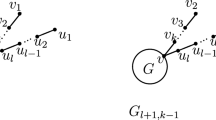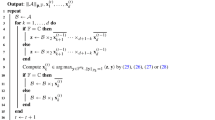Abstract
Let us define \(A=\operatorname{Circ}_{r}(a_{0},a_{1},\ldots,a_{n-1})\) to be a \(n\times n\) r-circulant matrix. The entries in the first row of \(A=\operatorname{Circ}_{r}(a_{0},a_{1},\ldots,a_{n-1})\) are \(a_{i}=F_{i}\), or \(a_{i}=L_{i}\), or \(a_{i}=F_{i}L_{i}\), or \(a_{i}=F_{i}^{2}\), or \(a_{i}=L_{i}^{2}\) (\(i=0,1,\ldots,n-1\)), where \(F_{i}\) and \(L_{i}\) are the ith Fibonacci and Lucas numbers, respectively. This paper gives an upper bound estimation of the spectral norm for r-circulant matrices with Fibonacci and Lucas numbers. The result is more accurate than the corresponding results of S Solak and S Shen, and of J Cen, and the numerical examples have provided further proof.
Similar content being viewed by others
1 Introduction
For \(n>0\), the Fibonacci sequence \(\{F_{n}\}\) is defined by \(F_{n+1}=F_{n}+F_{n-1}\), where \(F_{0}=0\) and \(F_{1}=1\). If we start by zero, then the sequence is given by
If we deduce from \(F_{n+1}\) that \(L_{n+1}=L_{n}+L_{n-1}\), and let \(L_{0}=2\), \(L_{1}=1\), then we obtain the Lucas sequence \(\{L_{n}\}\),
Furthermore, the sequences \(\{F_{n}\}\) and \(\{L_{n}\}\) satisfy the following recursion:
Definition 1.1
A matrix A is an r-circulant matrix if it is of the form
Obviously, the elements of this r-circulant matrix are determined by its first row elements \(a_{0},a_{1},\ldots,a_{n-1}\) and the parameter r, thus we denote \(A=\operatorname{Circ}_{r}(a_{0}, a_{1}, \ldots, a_{n-1})\). Especially when \(r=1\), we obtain \(A=\operatorname{Circ}(a_{0}, a_{1}, \ldots, a_{n-1})\).
Definition 1.2
A matrix A is called a symmetric r-circulant matrix if it is of the form
Obviously, the elements of this r-circulant matrix are determined by its first row elements \(a_{0},a_{1},\ldots,a_{n-1}\) and the parameter r; thus we denote \(A=\operatorname{SCirc}_{r}(a_{0}, a_{1}, \ldots, a_{n-1})\). Especially when \(r=1\), we obtain \(A=\operatorname{SCirc}(a_{0}, a_{1}, \ldots, a_{n-1})\).
For any \(A=(a_{ij})_{m\times n}\), the well-known spectral norm of the matrix A is
in which \(\lambda_{i} ( A^{H} A )\) is the eigenvalue of \(A^{H}A\) and \(A^{H}\) is the conjugate transpose of matrix A.
Define the maximum column length norm \(c_{1}(\cdot)\) and the maximum row length norm \(r_{1}(\cdot)\) of any matrix A by
and
respectively.
Let A, B, and C be \(m \times n\) matrices. If \(A=B\circ C\), then in accordance with [1] we have
and
Here, we define \(B=(b_{ij})_{m\times n}\), \(C=(c_{ij})_{m\times n}\), and we let \(B\circ C\) be the Hadamard product of B and C.
In recent years, many authors (see [2–6]) were concerned with r-circulant matrices associated with a number sequence. References [2–4] calculate and estimate the Frobenius norm and the spectral norm of a circulant matrix where the elements of the r-circulant matrix are Fibonacci numbers and Lucas numbers; the authors found more accurate results of the upper bound estimated, and the numerical examples also have provided further proof.
Theorem 1.3
(see [2])
Let \(A=\operatorname{Circ}(F_{0}, F_{1}, \ldots, F_{n-1})\) be a circulant matrix, then we have
where \(\|\cdot\|_{2}\) is the spectral norm and \(F_{n}\) denotes the nth Fibonacci number.
Theorem 1.4
(see [3])
Let \(A=\operatorname{Circ}(L_{0}, L_{1}, \ldots, L_{n-1})\) be a circulant matrix, then we have
where \(\|\cdot\|_{2}\) is the spectral norm, and \(L_{n}\) and \(F_{n}\) denote the nth Lucas and Fibonacci numbers, respectively.
Theorem 1.5
(see [4])
Let \(A=\operatorname{Circ}_{r}(F_{0}, F_{1}, \ldots, F_{n-1})\) be a r-circulant matrix, in which \(|r|\geq1\), and then
where \(r\in\mathbb{C}\), \(\|\cdot\|_{2}\) is the spectral norm and \(F_{n}\) denotes the nth Fibonacci number.
Theorem 1.6
(see [4])
Let \(A=\operatorname{Circ}_{r}(L_{0}, L_{1}, \ldots, L_{n-1})\) be a r-circulant matrix and \(|r|\geq1\), then we obtain
where \(r\in\mathbb{C}\), \(\|\cdot\|_{2}\) is the spectral norm, and \(L_{n}\) and \(F_{n}\) denote the nth Lucas and Fibonacci numbers, respectively.
2 Main results
Theorem 2.1
Let \(A=\operatorname{Circ}(F_{0}, F_{1}, \ldots, F_{n-1})\) be a circulant matrix, then we have
where \(\|\cdot\|_{2}\) is the spectral norm and \(F_{n}\) denotes the nth Fibonacci number.
Proof
Since \(A=\operatorname{Circ}(F_{0}, F_{1}, \ldots, F_{n-1})\) is a circulant matrix, let the matrices B and C be
we get \(A=B\circ C\).
For
and
From (4), we have
□
Corollary 2.2
Let \(A=\operatorname{SCirc}(F_{0}, F_{1}, \ldots, F_{n-1})\) be a symmetric circulant matrix, then we have
where \(\|\cdot\|_{2}\) is the spectral norm and \(F_{n}\) denotes the nth Fibonacci number.
Corollary 2.3
Let \(A=\operatorname{Circ}(F_{0}^{2}, F_{1}^{2}, \ldots, F_{n-1}^{2})\) be a circulant matrix, then we have
where \(\|\cdot\|_{2}\) is the spectral norm and \(F_{n}\) denotes the nth Fibonacci number.
Proof
Since \(A=\operatorname{Circ}(F_{0}^{2}, F_{1}^{2}, \ldots, F_{n-1}^{2})\) is a circulant matrix, if the matrices \(B=\operatorname{Circ}(F_{0}, F_{1}, \ldots, F_{n-1})\), we get \(A=B\circ B\); thus from (5) and Theorem 2.1 we obtain
□
Theorem 2.4
Let \(A=\operatorname{Circ}(L_{0}, L_{1}, \ldots, L_{n-1})\) be a circulant matrix, then we have
where \(\|\cdot\|_{2}\) is the spectral norm and \(L_{n}\) denotes the Lucas number.
Proof
Since \(A=\operatorname{Circ}(L_{0}, L_{1}, \ldots, L_{n-1})\) is a circulant matrix, let the following matrices be defined:
then \(A=B\circ C\).
We have
and
Here
thus
and from (4) we obtain
□
Corollary 2.5
Let \(A=\operatorname{SCirc}(L_{0}, L_{1}, \ldots, L_{n-1})\) be a symmetric circulant matrix, then we have
where \(\|\cdot\|_{2}\) is the spectral norm, and \(L_{n}\) and \(F_{n}\) denote the nth Lucas and Fibonacci numbers, respectively.
Corollary 2.6
Let \(A=\operatorname{Circ}(L_{0}^{2}, L_{1}^{2}, \ldots, L_{n-1}^{2})\) be circulant matrices, then
where \(\|\cdot\|_{2}\) is the spectral norm, and \(L_{n}\) and \(F_{n}\) denote the nth Lucas and Fibonacci numbers, respectively.
Proof
Since \(A=\operatorname{Circ}(L_{0}^{2}, L_{1}^{2}, \ldots, L_{n-1}^{2})\) is a circulant matrix, if the matrices \(B=\operatorname{Circ}(L_{0}, L_{1}, \ldots, L_{n-1})\), we get \(A=B\circ B\); thus from (5) and Theorem 2.4, we obtain
□
Corollary 2.7
Let \(A=\operatorname{Circ}(F_{0}L_{0}, F_{1}L_{1}, \ldots, F_{n-1}L_{n-1})\) be circulant matrices, then
where \(\|\cdot\|_{2}\) is the spectral norm, and \(L_{n}\) and \(F_{n}\) denote the nth Lucas and Fibonacci numbers, respectively.
Proof
Since \(A=\operatorname{Circ}(F_{0}L_{0}, F_{1}L_{1}, \ldots, F_{n-1}L_{n-1})\) is a circulant matrix, if the matrices \(B=\operatorname{Circ}(F_{0}, F_{1}, \ldots, F_{n-1})\) and \(C=\operatorname{Circ}(L_{0}, L_{1}, \ldots, L_{n-1})\), we get \(A=B\circ C\); thus from (5), Theorems 2.1, and 2.4, we obtain
□
Theorem 2.8
Let \(A=\operatorname{Circ}_{r}(F_{0}, F_{1}, \ldots, F_{n-1})\) be a r-circulant matrix, in which \(|r|\geq1\), and then
where \(r\in\mathbb{C}\), \(\|\cdot\|_{2}\) is the spectral norm and \(F_{n}\) denotes the nth Fibonacci number.
Proof
Since \(A=\operatorname{Circ}_{r}(F_{0}, F_{1}, \ldots, F_{n-1})\) is a r-circulant matrix, let B and C, respectively, be
then \(A=B\circ C\).
For
and
from (4), we have
□
Corollary 2.9
Let \(A=\operatorname{SCirc}_{r}(F_{0}, F_{1}, \ldots, F_{n-1})\) be a symmetric r-circulant matrix, in which \(|r|\geq1\), and then
where \(r\in\mathbb{C}\), \(\|\cdot\|_{2}\) is the spectral norm and \(F_{n}\) denotes the nth Fibonacci number.
Corollary 2.10
Let \(A=\operatorname{Circ}_{r}(F_{0}^{2}, F_{1}^{2}, \ldots, F_{n-1}^{2})\) be a r-circulant matrix, while \(|r|\geq1\), then we obtain
where \(r\in\mathbb{C}\), \(\|\cdot\|_{2}\) is the spectral norm and \(F_{n}\) denotes the Fibonacci number.
Proof
Since \(A=\operatorname{Circ}_{r}(F_{0}^{2}, F_{1}^{2}, \ldots, F_{n-1}^{2})\) is a r-circulant matrix, if the matrices \(B=\operatorname{Circ}_{r}(F_{0}, F_{1}, \ldots, F_{n-1})\) and \(C=\operatorname{Circ}(F_{0}, F_{1}, \ldots, F_{n-1})\), we get \(A=B\circ C\); thus from (5), Theorems 2.1, and 2.8, we obtain
□
Corollary 2.11
Let \(A=\operatorname{Circ}_{r}(F_{0}L_{0}, F_{1}L_{1}, \ldots, F_{n-1}L_{n-1})\) be a r-circulant matrix, while \(|r|\geq1\), then we obtain
where \(r\in\mathbb{C}\), \(\|\cdot\|_{2}\) is the spectral norm, and \(L_{n}\) and \(F_{n}\) denote the nth Lucas and Fibonacci numbers, respectively.
Proof
Since \(A=\operatorname{Circ}_{r}(F_{0}L_{0}, F_{1}L_{1}, \ldots, F_{n-1}L_{n-1})\) is a r-circulant matrix, if the matrices \(B=\operatorname{Circ}_{r}(F_{0}, F_{1}, \ldots, F_{n-1})\) and \(C=\operatorname{Circ}(L_{0}, L_{1}, \ldots, L_{n-1})\), we get \(A=B\circ C\); thus from (5), Theorems 2.4, and 2.8, we obtain
□
Theorem 2.12
Let \(A=\operatorname{Circ}_{r}(L_{0}, L_{1}, \ldots, L_{n-1})\) be a r-circulant matrix and \(|r|\geq1\), then we obtain
where \(r\in\mathbb{C}\), \(\|\cdot\|_{2}\) is the spectral norm, and \(L_{n}\) and \(F_{n}\) denote the nth Lucas and Fibonacci numbers, respectively.
Proof
Since \(A=\operatorname{Circ}_{r}(L_{0}, L_{1}, \ldots, L_{n-1})\) is a r-circulant matrix, let B and C, respectively, be
and then \(A=B\circ C\).
We have
and
in which
and we get
From (4), we further infer
□
Corollary 2.13
Let \(A=\operatorname{SCirc}_{r}(L_{0}, L_{1}, \ldots, L_{n-1})\) be a symmetric r-circulant matrix and \(|r|\geq1\), then we obtain
where \(r\in\mathbb{C}\), \(\|\cdot\|_{2}\) is the spectral norm, and \(L_{n}\) and \(F_{n}\) denote the nth Lucas and Fibonacci numbers, respectively.
Corollary 2.14
Let \(A=\operatorname{Circ}_{r}(L_{0}^{2}, L_{1}^{2}, \ldots, L_{n-1}^{2})\) be a r-circulant matrix and \(|r|\geq1\), then
where \(r\in\mathbb{C}\), \(\|\cdot\|_{2}\) is the spectral norm, and \(L_{n}\) and \(F_{n}\) denote the nth Lucas and Fibonacci numbers, respectively.
Proof
Since \(A=\operatorname{Circ}_{r}(L_{0}^{2}, L_{1}^{2}, \ldots, L_{n-1}^{2})\) is a r-circulant matrix, if the matrices \(B=\operatorname{Circ}(L_{0}, L_{1}, \ldots, L_{n-1})\) and \(C=\operatorname{Circ}_{r}(L_{0}, L_{1}, \ldots, L_{n-1})\), we get \(A=B\circ C\); thus from (5), Theorems 2.4, and 2.12, we obtain
□
3 Examples
Example 1
Let \(A=\operatorname{Circ}(F_{0}, F_{1}, \ldots, F_{n-1})\) be a circulant matrix, in which \(F_{i}\) (\(i=0,1,\ldots,n-1\)) denotes the Fibonacci number.
From Table 1, it is easy to find that the upper bounds for the spectral norm, of Theorem 2.1 are more accurate than Theorem 1.3 when \(n\geq4\).
Example 2
Let \(A=\operatorname{Circ}(L_{0}, L_{1}, \ldots, L_{n-1})\) be a circulant matrix, where \(L_{i}\) (\(i=0,1,\ldots,n-1\)) denotes the Lucas sequence.
Let \(n\geq3\), and it is easy to find that the upper bounds for the spectral norm of Theorem 2.4 are more accurate than Theorem 1.4 (see Table 2).
Example 3
Let \(A=\operatorname{Circ}_{2}(F_{0}, F_{1}, \ldots, F_{n-1})\) be a 2-circulant matrix, in which \(F_{i}\) (\(i=0,1,\ldots,n-1\)) denotes the Fibonacci number.
Let \(n\geq4\), and it is easy to find that the upper bounds for the spectral norm of Theorem 2.8 are more precise than Theorem 1.5 (see Table 3).
Example 4
Let \(A=\operatorname{Circ}_{2}(L_{0}, L_{1}, \ldots, L_{n-1})\) be a 2-circulant matrix where \(L_{i}\) (\(i=0,1,\ldots, n-1\)) denotes the Lucas sequence.
It can be seen from Table 4 that the upper bounds for the spectral norm of Theorem 2.12 are more precise than Theorem 1.6 when \(n\geq3\).
References
Mathias, R: The spectral norm of a nonnegative matrix. Linear Algebra Appl. 131, 269-284 (1990)
Solak, S: On the norms of circulant matrices with the Fibonacci and Lucas numbers. Appl. Math. Comput. 160, 125-132 (2005)
Solak, S: Erratum to ‘On the norms of circulant matrices with the Fibonacci and Lucas numbers’ [Appl. Math. Comput. 160 (2005) 125-132]. Appl. Math. Comput. 190, 1855-1856 (2007)
Shen, S, Cen, J: On the bounds for the norms of r-circulant matrices with the Fibonacci and Lucas numbers. Appl. Math. Comput. 216, 2891-2897 (2010)
Yazlik, Y, Taskara, N: On the norms of an r-circulant matrix with the generalized k-Horadam numbers. J. Inequal. Appl. 2013, 394 (2013)
Bozkurt, D, Tam, T-Y: Determinants and inverses of r-circulant matrices associated with a number sequence. Linear Multilinear Algebra (2014). doi:10.1080/03081087.2014.941291
Acknowledgements
Project supported by Applied Fundamental Research Plan of Sichuan Province (No. 2013JY0178).
Author information
Authors and Affiliations
Corresponding author
Additional information
Competing interests
The authors declare that they have no competing interests.
Authors’ contributions
All authors contributed equally to the writing of this paper. All authors read and approved the final manuscript.
Rights and permissions
Open Access This is an Open Access article distributed under the terms of the Creative Commons Attribution License (http://creativecommons.org/licenses/by/4.0), which permits unrestricted use, distribution, and reproduction in any medium, provided the original work is properly credited.
About this article
Cite this article
He, C., Ma, J., Zhang, K. et al. The upper bound estimation on the spectral norm of r-circulant matrices with the Fibonacci and Lucas numbers. J Inequal Appl 2015, 72 (2015). https://doi.org/10.1186/s13660-015-0596-5
Received:
Accepted:
Published:
DOI: https://doi.org/10.1186/s13660-015-0596-5




